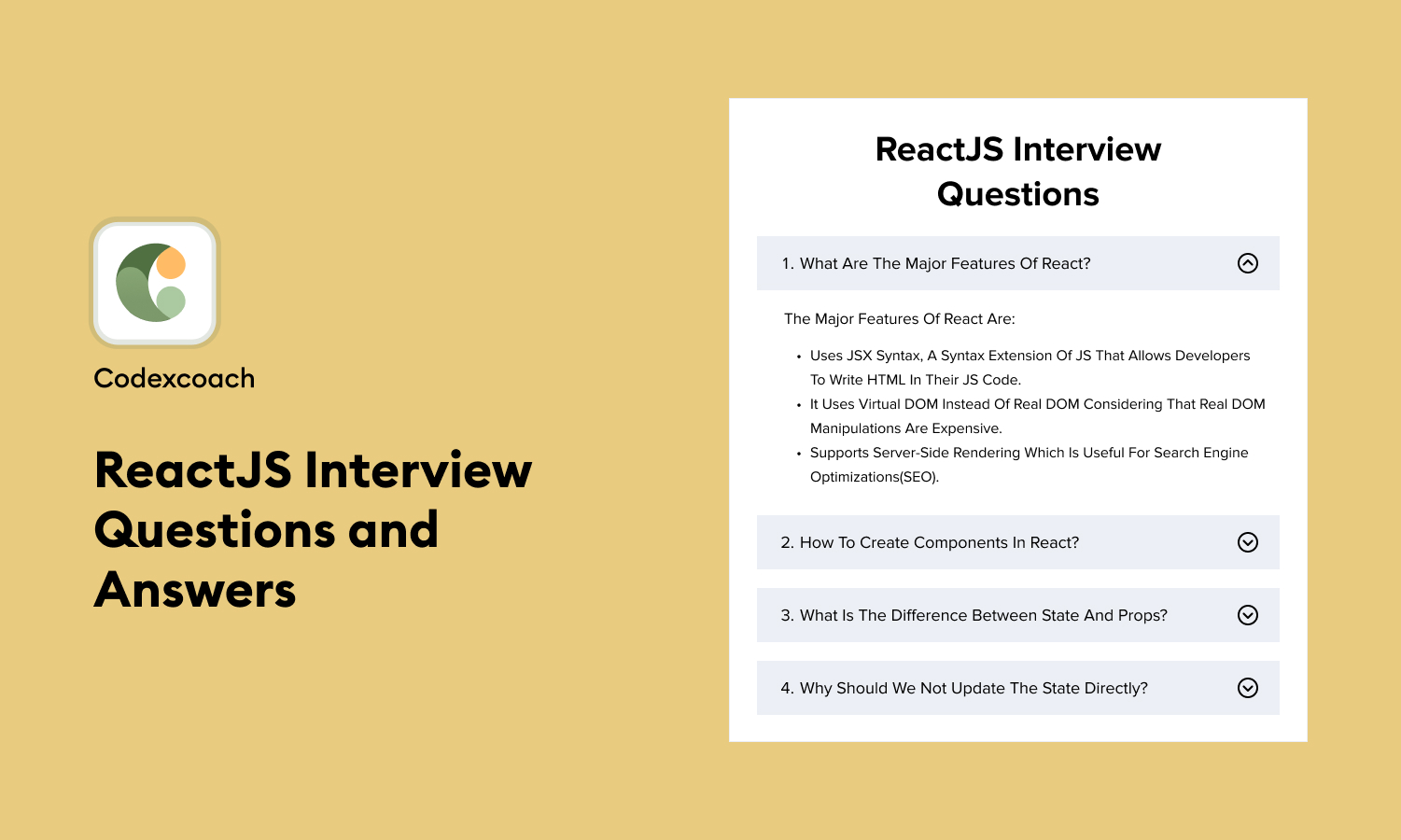Introduction
As a budding developer or someone learning programming, it’s crucial to familiarize yourself with popular frameworks and libraries. ReactJS is one such popular JavaScript library used for building user interfaces. As you progress in your programming journey, you’ll likely encounter ReactJS technical questions during coding interviews.
In this blog post, we will explore the ReactJS technical interview questions and provide you with detailed answers, code examples, and analogies to help you understand the concepts better. So, let’s get started!
1. What is ReactJS?
ReactJS is a JavaScript library used for building user interfaces. Created by Facebook, React focuses on the ‘view’ aspect of the Model-View-Controller (MVC) architecture. It excels in building reusable components and managing the state of those components. React works through a virtual DOM, enabling more efficient updates and rendering. It is widely used in single-page applications where you need a fast and interactive user experience. The library has gained immense popularity due to its performance, community support, and the richness of its ecosystem, which includes tools like React Native for mobile app development.
2. What is JSX?
JSX stands for JavaScript XML. It is a syntax extension for JavaScript that allows you to write HTML-like elements and components in a JavaScript file. JSX is transcompiled by tools like Babel into standard JavaScript objects that the browser can understand. With JSX, you can create custom components and use them in a declarative way, which makes the code more readable and maintainable. JSX is not a necessity for using ReactJS, but it simplifies the process of describing what the UI should look like, making it a key part of the React ecosystem.
3. What is the Virtual DOM?
The Virtual DOM (Document Object Model) is an in-memory representation of the actual DOM elements. The rendering engine can quickly make changes to the Virtual DOM and subsequently update the real DOM in a more optimized and efficient way. This is faster than updating the real DOM directly because direct manipulation is costly in terms of performance. When a change occurs, ReactJS creates a new Virtual DOM and compares it with the previous one, using a “diffing” algorithm to determine the minimal number of changes required, and then updates only those changes in the actual DOM.
Component Questions
1. What are functional components?
Functional components are a simpler way to write components in ReactJS. They are just JavaScript functions that take props as an argument and return JSX to render. Introduced in React 16.8, functional components don’t have lifecycle methods or their own state (prior to the introduction of Hooks). They are easier to understand, and test, and often result in less code. Many developers prefer functional components because of their simplicity and the ability to use React Hooks, which bring features like state management and side effects into functional components.
2. What are class components?
Class components are another way to define React components and they use ES6 class syntax. Unlike functional components, class components allow you to use features like lifecycle methods and local states. A class component must have a render method, which returns JSX. They are especially useful when you need more control over the component’s behavior, like when to initialize or destroy resources. However, with the advent of Hooks, many of the unique features of class components can now be replicated in functional components.
3. What is a React State?
State in ReactJS represents a component’s local data or information that can change over time. Each component can have its own local state, managed within the component itself or with state management libraries like Redux. The setState method in class components and the useState hook in functional components are commonly used to update the state. State changes are asynchronous and trigger a re-render of the component, allowing for dynamic and interactive user interfaces.
Lifecycle Methods
1. What is componentDidMount?
The componentDidMount method is one of React’s lifecycle hooks, specific to class components. It gets invoked immediately after a component is added to the DOM. This is an ideal place to run setup logic, like initializing third-party libraries, setting up subscriptions, or fetching data from an API. This hook lets you know that your component’s output is on the DOM and is ready for manipulation if needed. It’s commonly used for actions that require the DOM elements to be available or that need to run only once after the initial render.
2. When is componentWillUnmount called?
The componentWillUnmount lifecycle method is called right before a component is removed from the DOM. This is your opportunity to perform any necessary cleanup such as invalidating timers, canceling API calls, or removing event listeners. Failing to clean up can lead to memory leaks and other issues. Essentially, componentWillUnmount allows you to optimize performance and ensure that your component doesn’t leave any unwanted residual effects in your application.
Hooks
1. What is useState?
The useState hook is a feature in ReactJS that allows you to add state to functional components. Introduced in React 16.8, useState takes the initial state as an argument and returns an array containing the current state and a function to update it. This makes it easier to manage state in functional components, without having to convert them into class components. The hook triggers a re-render of the component whenever the state is updated, ensuring the UI is always in sync with the data.
2. What is useEffect?
The useEffect hook serves the same purpose as lifecycle methods in class components but is tailored for functional components. It runs after the initial render and after every update (re-render), combining the roles of componentDidMount, componentDidUpdate, and componentWillUnmount. It takes a function as its first argument, where you can perform side-effects like data fetching, manual DOM manipulations, and subscriptions. Optionally, you can pass a dependency array as the second argument to control when the effect runs.
Advanced Topics
1. What is Redux?
Redux is a state management library often used in combination with ReactJS. It helps you manage the global state in your application, making it easier to keep track of changes in state over time. In a Redux-enabled application, the state is stored in a single immutable object, enabling more predictable behavior and easier debugging. Actions are dispatched to modify the state, and Reducers process these actions to provide a new state. Redux is particularly useful for large applications where the local component state doesn’t suffice.
2. What is Context API?
Context API is a feature of React that allows you to share a global state and pass it through the component tree without having to manually pass props down through multiple levels. This makes it easier to manage the state that is needed by many parts of your application, like user authentication or theme settings. The Context API provides a Provider component to set the context values and a Consumer or useContext hook to read those values in child components.
3. What is a React Router?
React Router is a standard library for routing in ReactJS applications. It allows you to define multiple routes with different components to display, enabling navigation and URL management in single-page applications. With React Router, you can create complex applications that can navigate between different views conditionally based on user interaction, while keeping the UI in sync with the URL.
4. What is Prop Drilling?
Prop drilling is a term used to describe the process where you have to pass props from one component down through several layers of the component tree to get them to their required destination. This can lead to code that is harder to maintain and understand. Solutions like Context API or state management libraries like Redux are commonly used to solve this problem by providing a centralized state that can be accessed throughout the component tree.
5. What are React Hooks?
ReactJS Hooks are functions that allow you to use state and lifecycle features in functional components, without converting them to class components. Introduced in ReactJS 16.8, hooks provide a way to share stateful logic between components. Common hooks include useState for state management, useEffect for side effects, and useContext for accessing the Context API. Custom hooks can also be created to encapsulate complex logic and make components more readable and reusable.
6. What is memoization in React?
Memoization is a programming technique used in ReactJS to optimize performance by caching the output of expensive function calls and reusing it when the same inputs occur again. The React.memo function and the useMemo hook are common ways to implement memoization. They help prevent unnecessary renders by shallowly comparing the current and previous props or states, making the application more efficient, particularly when rendering large lists or complex components.
Conclusion
In this blog post, we’ve covered common ReactJS technical questions that you might encounter in interviews. We’ve provided explanations to help you understand the concepts and prepare for your interview.





